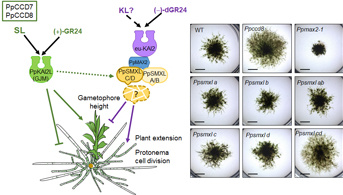SMXL proteins repress moss growth through a conserved ancestral signaling pathway
The signal triggering this pathway remains to be discovered - SAS team article published in The Plant Cell
Until 2008, strigolactones (SLs) were known as rhizosphere chemical signals, essential for the establishment of endomycorrhizae, but also inducing germination of parasitic plant seeds. The discovery of the role of SLs in controlling plant aerial architecture paved the way for numerous studies aimed at deciphering this new hormonal signalling pathway. The study of SL perception has revealed another signalling pathway, called the KAI2 ligand (KL) pathway, whose triggering signal remains unknown. The SUPPRESSOR OF MAX2 1-LIKE (SMXL) gene family encodes repressor proteins for each of these two pathways. Their degradation lifts the inhibition of the processes controlled by SL or KL.
In a study published in the Plant Cell, Ambre Guillory and her colleagues from "Strigolactones and Allelochemicals Signaling" SAS team and collaborators fron the ICSN, have characterized the homologs of SMXL genes in a bryophyte (non-vascular plant), the moss Physcomitrium patens (4 PpSMXLA-D genes). In P. patens, SLs repress filament growth and branching, and promote gametophore (leafy shoot) development. The KL pathway has opposite effects on moss development. P. patens mutants in the PpSMXL genes were obtained by CRISPR-Cas9 mutagenesis, as were lines overexpressing PpSMXL proteins. Their characterization, and the mutants' reduced sensitivity to a KL mimic, indicate that PpSMXL proteins act as repressors of KL signaling. Furthermore, Ppsmxlcd double mutants are globally insensitive to an SL analog, suggesting that PpSMXLC and D may also positively regulate the SL response.
The mode of action of PpSMXL proteins in KL signaling in the moss P. patens resembles that described in flowering plants and in another bryophyte of the genus Marchantia. This function would therefore be ancestral in land plants. In contrast, the function of the PpSMXLC and D proteins in SL signaling may be specific to mosses, a possibility of convergent evolution that warrants further study.
Research developed at the Institute Jean-Pierre Bourgin for Plant Sciences in collaboration

In a study published in the Plant Cell, Ambre Guillory and her colleagues from "Strigolactones and Allelochemicals Signaling" SAS team and collaborators fron the ICSN, have characterized the homologs of SMXL genes in a bryophyte (non-vascular plant), the moss Physcomitrium patens (4 PpSMXLA-D genes). In P. patens, SLs repress filament growth and branching, and promote gametophore (leafy shoot) development. The KL pathway has opposite effects on moss development. P. patens mutants in the PpSMXL genes were obtained by CRISPR-Cas9 mutagenesis, as were lines overexpressing PpSMXL proteins. Their characterization, and the mutants' reduced sensitivity to a KL mimic, indicate that PpSMXL proteins act as repressors of KL signaling. Furthermore, Ppsmxlcd double mutants are globally insensitive to an SL analog, suggesting that PpSMXLC and D may also positively regulate the SL response.
The mode of action of PpSMXL proteins in KL signaling in the moss P. patens resembles that described in flowering plants and in another bryophyte of the genus Marchantia. This function would therefore be ancestral in land plants. In contrast, the function of the PpSMXLC and D proteins in SL signaling may be specific to mosses, a possibility of convergent evolution that warrants further study.
Research developed at the Institute Jean-Pierre Bourgin for Plant Sciences in collaboration

Back

Zoom
Legend: Current model of KAI2 Ligand (KL) and strigolactone (SL) signaling in P. patens. SLs and putative KL signal are mimicked by (+)-GR24 and (-)-desmethyl GR24 ((-)- dGR24) respectively, and perceived by receptors of PpKAI2L(GJM) clade and eu-KAI2 clade respectively (black arrows). SL and KL pathways (green and purple arrows respectively) have opposite effects on protonema extension and gametophore development. Pointed arrows symbolize positive effect, while flat head arrows symbolize negative effect. In contrast to angiosperms, only the KL pathway is PpMAX2 dependent. All four PpSMXL are likely suppressors of the KL pathway, though their PpMAX2-dependent degradation following KL/(-)-dGR24 perception has not fully been demonstrated (question mark). The green dotted arrow indicates that PpSMXL could be stabilized by SLs. Photos: Phenotypes of wild type (WT) and mutants Ppccd8 (SL-deficient), Ppmax2 (KL-insensitive), single and double mutants of PpSMXL genes. 3 weeks old plants. Bare= 5 mm
Legend: Current model of KAI2 Ligand (KL) and strigolactone (SL) signaling in P. patens. SLs and putative KL signal are mimicked by (+)-GR24 and (-)-desmethyl GR24 ((-)- dGR24) respectively, and perceived by receptors of PpKAI2L(GJM) clade and eu-KAI2 clade respectively (black arrows). SL and KL pathways (green and purple arrows respectively) have opposite effects on protonema extension and gametophore development. Pointed arrows symbolize positive effect, while flat head arrows symbolize negative effect. In contrast to angiosperms, only the KL pathway is PpMAX2 dependent. All four PpSMXL are likely suppressors of the KL pathway, though their PpMAX2-dependent degradation following KL/(-)-dGR24 perception has not fully been demonstrated (question mark). The green dotted arrow indicates that PpSMXL could be stabilized by SLs. Photos: Phenotypes of wild type (WT) and mutants Ppccd8 (SL-deficient), Ppmax2 (KL-insensitive), single and double mutants of PpSMXL genes. 3 weeks old plants. Bare= 5 mm
Scientific Contact:
Sandrine Bonhomme, équipe SAS
Référence:
A Guillory, M Lopez-Obando, K Bouchenine, P Le Bris, A Lécureuil, JP Pillot, V Steinmetz, FD Boyer, C Rameau, A de Saint Germain, S Bonhomme. SUPPRESSOR OF MAX2 1-LIKE (SMXL) homologs are MAX2-dependent reprSessors of Physcomitrium patens growth. The Plant Cell. January
Doi : https://doi.org/10.1093/plcell/koae009